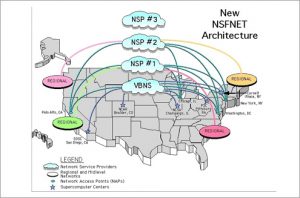New Internet architecture with commercial ISPs connected at NAP


Date: 01/01/1995
By 1993, the NSFNET decided to defund the NSFNET and do away with the AUP in order to promote commercialization of the Internet. Many commercial Internet networks came online during this time. In fact, the regional networks that were originally supported by the NSF turned into commercial service providers, including UUNet, PSINet, BBN, Intermedia, Netcom, and others.
The NSF’s plan for privatization included the creation of NAPs (network access points), which are Internet exchanges with open access policies that support commercial and international traffic. One can think of the NAPs as being like airports that serve many different airlines. The airlines lease airport space and use its facilities. Likewise, NSPs lease space at NAPs and use their switching facilities to exchange traffic with other parts of the Internet.
Part of NSF’s strategy was that all NSPs that received government funding must connect to all the NAPs. In 1993, the NFS awarded NAP contracts to MFS (Metropolitan Fiber Systems) Communications for a NAP in Washington, D.C., Ameritech for a NAP in Chicago, Pacific Bell for a NAP in San Francisco, and Sprint for a NAP in New York. MFS already operated MAEs (metropolitan area exchanges) in Washington, D.C. (MAE East) and in California’s Silicon Valley (MAE West). A MAE is a fiber-optic loop covering a metropolitan area that provides a connection point for local service providers and businesses.
A NAP is a physical facility with equipment racks, power supplies, cable trays, and facilities for connecting to outside communication systems. The NAP operator installs switching equipment. Originally, NAPs used FDDI and switched Ethernet, but ATM switches or Gigabit Ethernet switches are common today. NSPs install their own routers at the NAP and connect them to the switching facilities, as shown in Figure I-5. Thus, traffic originating from an ISP crosses the NSP’s router into the NAP’s switching facility to routers owned by other NSPs that are located at the NAP. Refer to Geoff Huston’s paper called “Interconnection, Peering, and Settlements” at the Web address listed on the related entries page for a complete discussion of NAPs and peering.
Most NAPs now consist of core ATM switches surrounded by routers. Traffic is exchanged across ATM PVCs (permanent virtual circuits). Usually, a NAP provides a default fully meshed set of PVCs that provide circuits to every other NSP router located at the NAP. However, an NSP can remove a PVC to block traffic from a particular NSP. However, larger NSPs may not want to peer with smaller NSPs because there is no equal exchange of traffic. A rule of thumb is that NSPs with a presence at every NAP peer with one another on an equal basis.
NAP operators do not establish peering agreements between NSPs, but only provide the facilities where peering can take place. Peering agreements are bilateral agreements negotiated between NSPs that define how they will exchange traffic at the NAPs. In addition, all IP datagram routing is handled by the NSP’s equipment. However, the NAP provides the switching equipment over which the packets traverse after being routed.
The NSF also funded the creation of the Routing Arbiter service, which provided routing coordination in the form of a route server and a routing arbiter database (RADB). Route servers would handle routing tasks at NAPs while the RADB generated the route server configuration files. RADB was part of a distributed set of databases known as the Internet Routing Registry, a public repository of announced routes and routing policy in a common format. NSPs use information in the registry to configure their backbone routers.
Today, Internet exchanges are only one part of the Internet architecture. Many NSPs establish private peering arrangements, as previously mentioned. A private connection is a direct physical link that avoids forwarding traffic through the NAPs switching facility, which is often overburdened. NSPs create private connections in two ways. One method is to run a cable between their respective routers at the NAP facility. Another more costly approach is to lay cable or lease lines between their own facilities.
Internap Network Services Corporation provides an Internet exchange service designed to maximize performance. Its Assimilator proprietary technology provides intelligent routing and route management to extend and enhance BGP4 routing. Assimilator allows the P-NAP to make intelligent routing decisions, such as choosing the faster of multiple backbones to route data if the destination is multihomed. Internap customer packets are sent immediately to the correct Internet backbone, rather than to a randomly chosen public or private peering point.